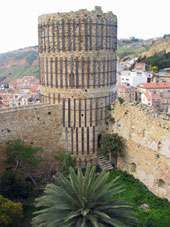Archaeologist uncover possible medieval mosque in Sicily

Earlier this summer, while standing in an archaeological pit adjacent to an ancient hilltop castle in west-central Sicily, Northern Illinois University graduate student Bill Balco could literally reach out and touch the centuries—even the millennia.
The dig site, about 7-by-10 meters near the castle entrance, reveals a crossroads of cultures and history: remnants of post-World War I floor tiles, a wall trench dating to the Renaissance, an 11th-century Norman fortification wall, a fourth-century-B.C Hellenistic house and a sixth-century-B.C. dwelling constructed by the indigenous Elymian people.
Amidst such an archaeological treasure trove, another discovery was uncovered in June—the base of an ancient column. In a country that boasts the seat of Roman Catholicism, the column base and an adjacent section of gypsum flooring represent a potentially surprising find—the ruins of what is believed to have been an early medieval mosque, dating to the ninth or 10th century.
“In one spot, you can sit on the mosque floor, eye-level with the modern city, resting an arm on a Norman fortification wall with one foot near what’s left of a house from the fourth century B.C. and another resting near the ruins of a dwelling from the sixth century B.C.,” Balco says.
Balco, of St. Charles, who will graduate from NIU in August with a master’s degree in anthropology, served as a teaching assistant on this field-school expedition to the village of Salemi, Sicily. It was led by NIU archaeologist Michael Kolb, a professor of anthropology.
Kolb and his field-school students have been digging each summer since 2004 at the castle of Salemi, on a quest to find evidence of the “lost city of Alicia,” which flourished more than 2,300 years ago. While Kolb was well aware of the Islamic history in Sicily, he never expected to find direct evidence of its presence.
Sicily has been predominantly Roman Catholic for hundreds of years. Yet, Arabs ruled the island for roughly 200 years before being conquered by the Normans in the 11th century. Most remnants of mosques have long been destroyed or built over, though the Arab influence remained apparent in later crafts and architecture. Even the name of the town, Salemi, has Arab origins.
“In an archaeological sense, the Arab or Islamic phase in Sicily is ephemeral—its duration was short and evidence of this period is very hard to find,” Kolb says.
His expedition members began uncovering the gypsum floor in 2004, but they were unable to place it into context until the column base was discovered.
“The gypsum floor is unusually large—about 15 to 20 square meters have been excavated—and the area is completely free of domestic artifacts, such as tableware or cookware,” Kolb says. “We believe it was a medieval public building, and our working hypothesis is that it was a mosque.
“It would seem to approach the dimensions of another early mosque in a nearby town that was 10-by-20 meters and also had a single column, but our structure is more elaborate because it uses a high quality gypsum plaster,” he adds. “Also, the structure’s southeast orientation fits that of a mosque, facing Mecca, and it was quickly destroyed during the Christian-Norman period. Still, the only way to be 100 percent conclusive would be to find the apse, which we hope to search for in future expeditions.”
The white gypsum flooring, about 5 inches thick, was excavated atop a jumble of Hellenistic ruins and near the remnants of the Norman fortification wall.
“This was one of the key years for tying the project together. This year answered a lot of questions,” says Balco, who has participated in five field-school expeditions to Sicily.
The Normans are believed to have built the castle of Salemi, which fell into ruin during the mid-20th century and was closed in the wake of a devastating earthquake in 1968 that damaged much of the village, which is still rebuilding.
Villagers have long claimed that Salemi and “the lost city” are one in the same, although the precise location of the Alicia, known in Greek as Halikyai, was lost through the ages. Cicero, the great Roman statesman, and two Greek historians, Thucydides and Diodorus Siculus, write of the settlement as a place of wealth and strategic importance, occupied by the Elymian peoples.
Over the past two decades, Salemi officials noted some old pieces of Greek pottery turning up during roadwork and water and sewer projects. Kolb and his Italian colleague, Pierfrancesco Vecchio, began excavations in other parts of the village in 2001.
This season produced no evidence of the lost city of Alicia, but in past years Kolb and his students have discovered tantalizing clues that would seem to support the villagers’ claims.
During previous digs at the castle site, Kolb’s group has retrieved the trappings of complex ancient civilizations: a bronze spearhead, vast amounts of table ceramics in excess of 2,000 years old, a rare gold earring dating to the third or fourth century B.C., a pendant adorned with the face of Athena, about two dozen Punic or Hellenistic coins, 36 loom weights stamped and painted with ornate designs, a ceramic vessel shaped like a Greek goddess and evidence of cooking and furnace technology.
“From all indications, Salemi was the site of Alicia,” Kolb says.
The archaeology work is part of reconstruction efforts. While local officials are working to rebuild houses and buildings, they also seek to solidify the community’s cultural and historic significance.
The castle is now undergoing renovation and will be home to a future museum, which might incorporate the archaeological dig into an exhibit for tourists. “Visitors could actually see the excavation and get a sense of the antiquity of the castle and region,” Kolb says. “The community is very excited about this.”
Source: Northern Illinois University





















